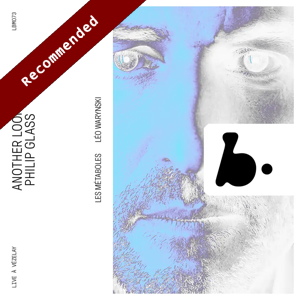
Another Look
Philip Glass (b. 1937)
Another Look at Harmony Part 4 (1977)
Andrea Basily (1706-1777)
Canone a 16 all’ unisono
Yoan Héreau (organ), Anne-Claire Baconnais (soprano)
Les Métaboles/Léo Warynski
rec. 2024, Cité de la Voix, Vézelay, France
B Records LBM073 [58]
Philip Glass is now so much associated with grand opera and big symphonic works – he recently completed his 15th symphony – that it is easy to forget how austere much of his earlier music sounds. This is no more so apparent than in this work Another Look at Harmony Part 4. Much of it was written after Music in Twelve Parts (1971-74) and while he was working on his groundbreaking opera Einstein on the Beach (1976). Indeed, Another Look at Harmony parts 1, 2 and 3 (1975) were rewritten and incorporated into that opera. Part 4 (1977), recorded here, is now the only free-standing work and was commissioned by the Holland Festival of 1977 and uses chorus and organ.
All four parts were intended as experiments in blending Glass’s additive rhythmic process with more complex harmonic progression, where harmony was more than the product of the accidental impact of interacting melodic lines. As the eight sections of the work progress, one can hear stylistic patterns that would rise to a greater prominence in his later works. There are some simple but shocking modulations and the choral chanting that is so much a part of his operatic work is heard here in its simplest form.
Much of Glass’s early works which included voice were written for one person per part which was then amplified. This gives the ‘classic’ recordings a unique sound with a uniformity in articulation and a very specific performance style. In addition, the organs used were electronic. This recording blows that stylistic understanding apart superbly.
Conductor by Léo Warynski has conducted a number of Glass’s operas and is therefore well versed in the demands of his music. The vocal group Les Métaboles, which he founded in 2010, is here eighteen in number and has no need for electronic amplification. The organ, likewise, is a classic organ not electronic, thus the sound world the group creates is light years away from what one expects from early Glass. The acoustic of the Cité de la Voix, the National Vocal Arts Centre of Burgundy-Franche-Comté, where the work was recorded, is wonderfully warm and adds a much welcome humanity to the sound.
The work takes the listener on a real journey. The opening with its F pedal on the organ and bare fourths and fifths from the choir sounds, if anything, like the realisation of a work by Perotin from the 13th century. Glass spent two years studying in Paris with Nadia Boulanger. As he has recounted, much of that time was spent writing exercises in strict counterpoint and singing Bach cantatas; we can, I think, hear the fruits of that labour here. The firm grounding in strict Western musical techniques underpins the sound world making it at once old and new. The unisons of movement one are elaborated on in part two etc. The shock of the modulation into part three is thrilling. There is a real sense of shape to the work as whole. The dynamic chanting of part four is forgotten in the quiet patterning of the organ in the wholly instrumental part five. Reversing that, the grandeur of the brief organ solo which is part seven leads majestically into the magnificence of the final part.
Robert Hugill in his review of an earlier choral version on Somm Recordings spoke of the “English Cathedral” style of the singers and that they seemed at times to be flagging in the repetitions. Happily, that is not the case here. Les Métaboles, are well versed in the demands of contemporary music and bring a sense of accuracy and grace to the performance. Organist Yoan Héreau’s fingers, and maybe feet, show no signs of exhaustion. RH said in his review that the Somm recording was “not necessarily the definitive recording”. Well, I think this superb performance probably is. The almost computer- like sound of early Glass is swept away and Léo Warynsk’s shaping of the music is coloured with careful rubato. He treats the music not as mechanical notes on the page but as a script to be interpreted. This is very like Glass’s own performance of his later works, faithful to the score but not a slave to it. I would urge you to set aside time to listen to the work in one sitting and not as separate movements. Like a walk around a great cathedral the journey is well worth it.
The disc ends with the first recording of a recently discovered, undated, perpetual canon by the little-known Andrea Basily. Initially, I thought the Baroque sounds a tad incongruous, but then thinking of Glass’s studies with Boulanger, this very strict piece of counterpoint seems entirely appropriate. The writing is flawless, and the choir sing it to perfection. I usually hate fade-outs in music but here the fade as the canon continues to eternity is beautifully atmospheric.
Paul RW Jackson
Buying this recording via a link below generates revenue for MWI, which helps the site remain free.




















